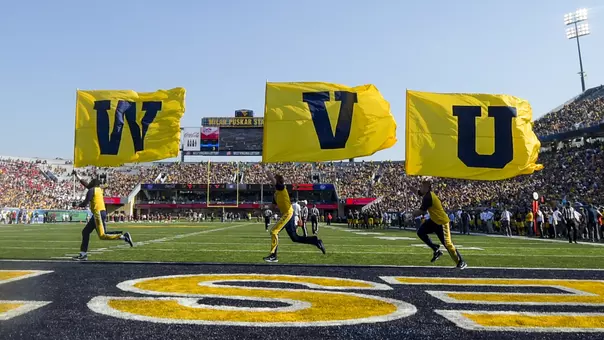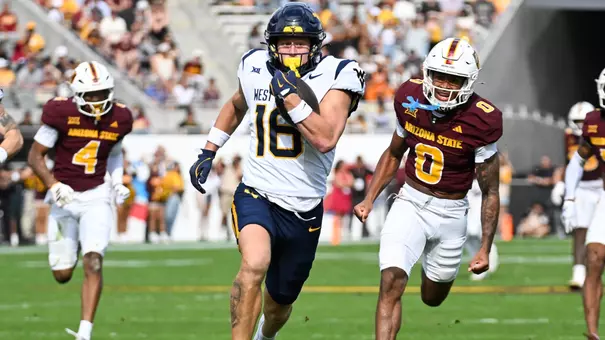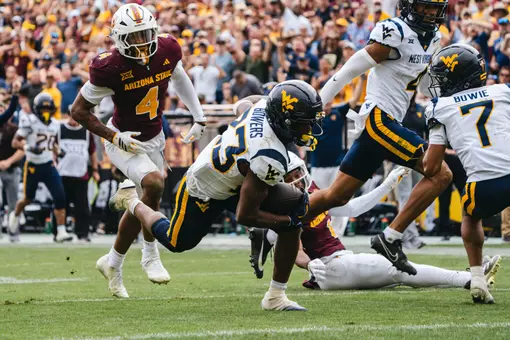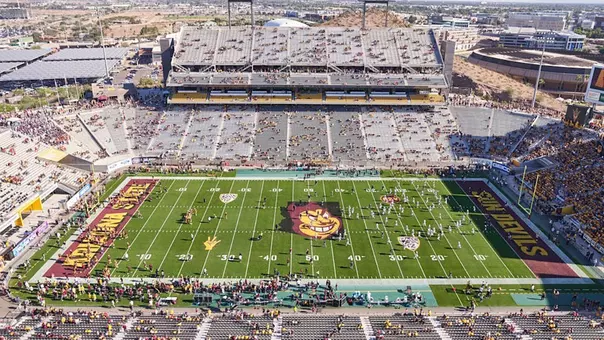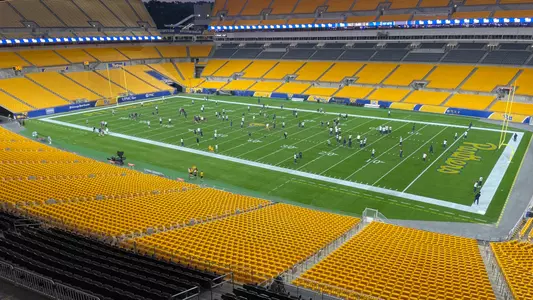
Countdown to Kickoff – The Backyard Brawl Renewed
September 01, 2022 09:09 AM | Football
PITTSBURGH – The talking, the stories, the articles, the pep rallies and the hype videos are finally beyond us and now it's time to play some football.
It's been 11 long years since the last time a West Virginia football coach had to get his team prepared to face Pitt, for decades Public Enemy No. 1 in the Mountain State.
Depending upon where you live in West Virginia, nothing good has ever come out of Pittsburgh, including the Steelers or the Penguins. That viewpoint softens considerably in the Northern Panhandle, where the Steelers, Penguins and Pirates can be easily separated from the Panthers. But around Parkersburg – the hometown of WVU director of athletics Shane Lyons – that's about where the line is usually drawn between Almost Heaven and Almost Hell.
The Mountaineers won five of the first six games against Pitt, then known as Western University of Pennsylvania, but then the Panthers claimed 29 of the next 34 games with a scoreless tie in 1909 sandwiched between two blowout WVU defeats.
During one depressing period between 1930 and 1934, West Virginia failed to score a single point in four straight losses and tallied lone touchdowns in 1934 and 1935 during an 11-year stretch when Pitt blanked West Virginia in nine of those 11 games.
To put that in modern-day terms, Pitt resembled Alabama and West Virginia was Vanderbilt, causing many to wonder out loud if the two schools should even continue playing.
In fact, Pitt actually dropped West Virginia from its schedule for a four-year period from 1939-43. The official reason was because it wanted to make room on its schedule for an invitation to the Western Conference (Big Ten) that never came. The unofficial reason was because of a financial dispute involving guaranteed money WVU owed Pitt for a game played in Morgantown in 1930 at the height of the Great Depression.
In the late 1930s, however, when Pitt's administration refused to keep up with Jock Sutherland's promises to his players, the two parted ways and the program began its long decline. There were some blips of success in the mid-1950s and early 1960s when John Michelosen coached the Panthers, but by the late-1960s, Pitt football was in a dire shape.
This was around the time when Pitt AD Frank Carver, Mr. Pitt for decades, agreed to finally play West Virginia on a home-and-home basis. Before then, most of the games were played in Pittsburgh because Pitt was clearly the better program, winning more than 75% of the games.
Depending upon your point of view, Carver was viewed as either Anwar Sadat or Neville Chamberlain regarding the Pitt-West Virginia football series.
"We still plan to play West Virginia," he once said in the mid-1960s. "We have played West Virginia since (1895). Just because we are losing to them now doesn't mean we should kick West Virginia off the schedule."
Carver added, "I remember the late 1930s, when every school was taking pot shots at us and West Virginia never said a word. They stuck by us, and I will never forget this. We will continue to play traditional opponents and games which either side has a 50-50 chance of winning."
Which is exactly what has happened since 1963, the year the rivalry became equal. West Virginia has won 25 games, Pitt 22 with two ties. Just an average of three points separate the two in those 49 games, in West Virginia's favor.
Pitt won seven games in a row from 1976-82 with WVU narrowly avoiding a 10-game losing streak when Bill McKenzie won the '75 game with a field goal on the final play, and Pitt averted an eight-game losing streak in the 1990s when the Panthers upset West Virginia 41-38 in triple overtime in 1997 in the first overtime game ever played at Mountaineer Field.
 After Pitt claimed back-to-back triumphs in 2007-08, West Virginia responded with three consecutive wins in 2009, 2010 and 2011 before conference realignment interceded and one of Eastern football's most storied rivalries became frozen in time.
After Pitt claimed back-to-back triumphs in 2007-08, West Virginia responded with three consecutive wins in 2009, 2010 and 2011 before conference realignment interceded and one of Eastern football's most storied rivalries became frozen in time.Other than Army-Navy and Lehigh-Lafayette, what other historical football rivalries are there in this part of the country? None. The Backyard Brawl is the only significant rivalry around here involving schools from power football conferences.
Pitt-Penn State?
Those two schools have played just four times since 2000 and have notoriously not gotten along together in the sandbox – much to the detriment of Eastern sports. The pettiness between those two once grew to the point in the late 1970s of arguing about where the coaches' wives sat during football games.
At any rate, the West Virginia-Pitt game has featured some of the greatest players and coaches in college football history. A combined 126 first-team All-Americans, 37 College Football and 12 Pro Football Hall of Famers, and more than 450 NFL players a have participated in this game.
Earlier this month, Neal Brown asked me to come over to the Puskar Center to give his guys a little historical perspective on the game – not a pep talk, but rather some cold, hard facts. After all, these guys were just starting grade school the last time the two teams played.
I asked them to raise their hands if they had ever played Pop Warner football in their youth. Of course, all of them put their hands in the air. I then told them that Pop Warner was a Pitt guy and our guy, Clarence Spears, once took his team to Pittsburgh in drab, gray uniforms and beat Pop Warner's boys 9-6 on a drop-kicked field goal by Armin Mahrt. That happened in 1922.
That's just a small sampling of the history of this football game. More will be made later this evening.
Here is tonight's Countdown to Kickoff:
10 – West Virginia and Pitt rank among the top TEN teams in terms of returning offensive line experience among Power 5 programs this year. Pitt has a combined 166 game's-worth of returning starting experience, while West Virginia has 124.
9 – The Mountaineers have lost just NINE times to Pitt since 1983 - the year the Mountaineers snapped Pitt's seven-game winning streak, the Panthers' longest during the modern era of college football.
8 – West Virginia and Pitt will play in EIGHT of the next 11 years (2022-25 and 2029-32).
7 – West Virginia has won the last SEVEN football and men's basketball games played against Pitt since the Panthers' 2008 football triumph in Pittsburgh.
6 – West Virginia has played SIX football games on Sept. 1, owning a 5-1 record overall. The last time the Mountaineers played on this date was in 2018 – a 40-14 win over Tennessee in Charlotte.
5 – Three of the top FIVE-attended football games in Milan Puskar Stadium history have involved Pitt in 1989 (68,938), 1991 (68,041) and 2003 (67,715).
4 – The 2002 Backyard Brawl ranks FOURTH in all-time attendance at Heinz Field (Acrisure Stadium) with 66,731 showing up to see No. 24 West Virginia knock off No. 17 Pitt 24-17.
3 – There were THREE ties in the 104-game history of the Backyard Brawl, those coming in 1909 (0-0), 1985 (10-10) and 1989 (31-31). WVU was riding a THREE-game winning streak against the Panthers when the series was interrupted after the 2011 game.
2 – West Virginia's largest margin of victory in the Backyard Brawl is 38 points, done TWO times in 1992 and 1998.
1 – Tonight's game will be the FIRST time Neal Brown and Pat Narduzzi have coached in a Backyard Brawl.
A 7 p.m. kickoff has been designated for tonight's game, to be televised nationally on ESPN (Matt Barrie, Louis Riddick and Harry Lyles Jr.). The contest was announced a sellout earlier this month. Mountaineer Sports Network from Learfield coverage on stations throughout West Virginia begins at 4 pm with the GoMart Mountaineer Tailgate Show, which leads into regular network coverage with Tony Caridi, Dwight Wallace and Jed Drenning at 6 pm. Fans can also access the broadcast on the popular mobile app WVU Gameday and online via WVUsports.com.
2005 Sugar Bowl Team Reunion
Wednesday, November 19
Jeff Weimer | Nov. 15
Saturday, November 15
Eddie Vesterinen | Nov. 15
Saturday, November 15
Rich Rodriguez | Nov. 15
Saturday, November 15
